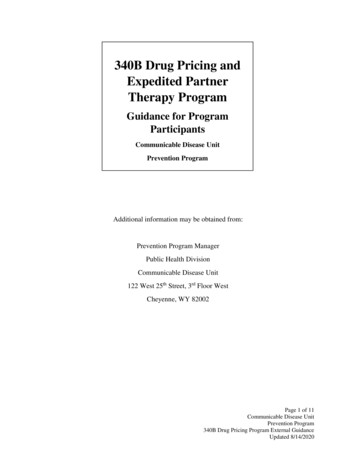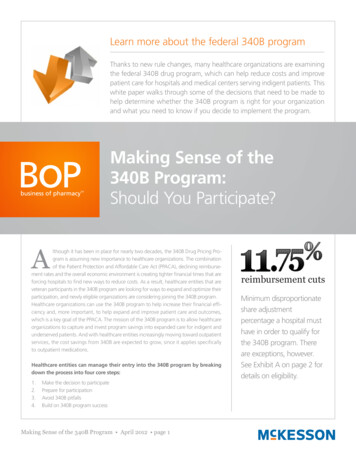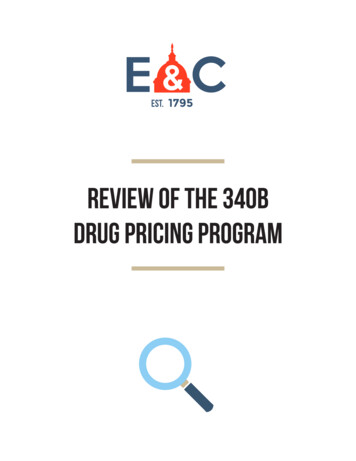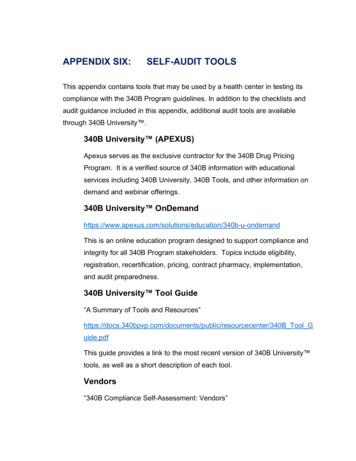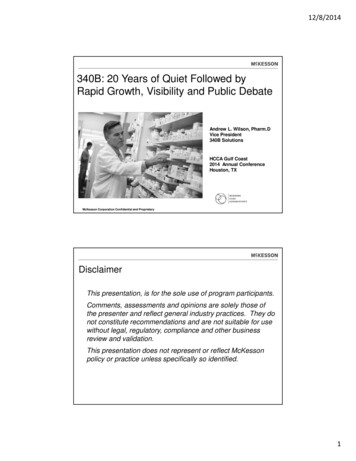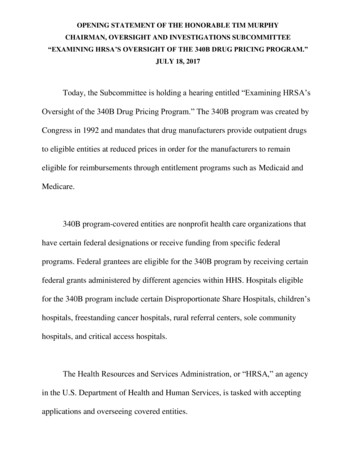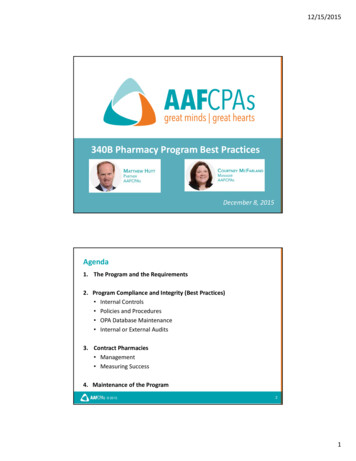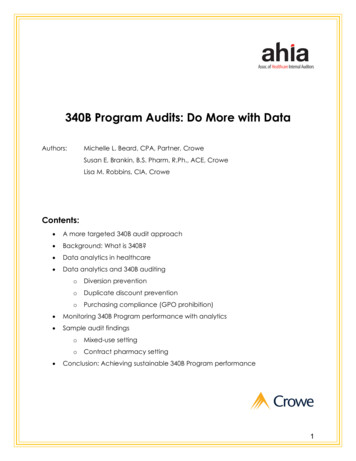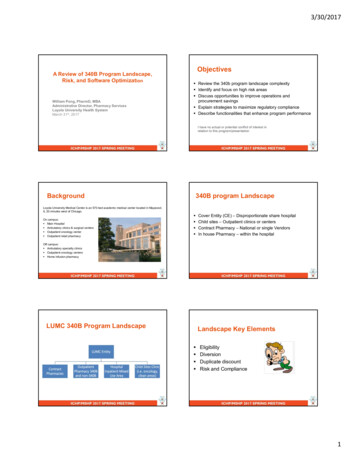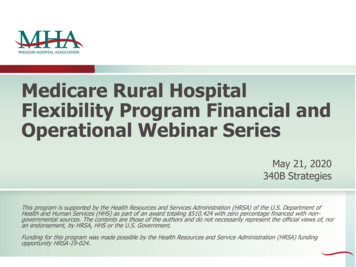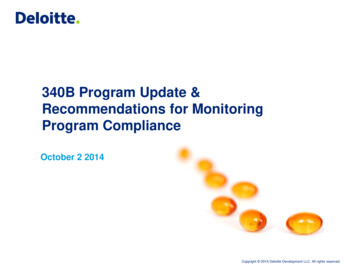
Transcription
340B Program Update &Recommendations for MonitoringProgram ComplianceOctober 2 2014Copyright 2014 Deloitte Development LLC. All rights reserved.
Speaker BiographyRay AlbertinaDirectorDeloitte & Touche LLP 1 (314) 342 4984ralbertina@deloitte.comRay is a Director in Deloitte & Touche LLP’s Business Risk Health Sciences practice. He has 35years of consulting experience in the healthcare industry. Prior to joining Deloitte, Ray was a Partnerin Ernst & Young’s Health Science Advisory Service practice where he served as the National coDirector of the Regulatory Reimbursement practice and as the National Director of the RevenueManagement.He has worked with clients on 340B projects for the past 15 years, planning and directing over 50340B projects for health systems, acute care and children’s hospitals. These engagements haveincluded: financial assessments, split billing software system selection, program compliance reviews,program expansion, implementation services and credit and rebill filings. This work has beenperformed for some of the largest health systems in the country.2Copyright 2014 Deloitte Development LLC. All rights reserved.
Objectives31Provide a brief overview of the Federal 340B Drug PricingProgram requirements2Describe the current regulatory landscape3Provide recommendations for monitoring programcompliance4Background on worked performed by Ray and his team atUC in 2012-2014 – key assessment findings5Q&ACopyright 2014 Deloitte Development LLC. All rights reserved.
1Overview of the 340B Program
340(b) Program Overview340(b) Program Criteria1.Hospital must have a Disproportionate Share AdjustmentPercentage of 11.75% or greater.2.Must be owned or operated by a unit of State or localgovernment, a non- profit corporation which is formallygranted governmental powers by a unit of State or localgovernment, or a private non-profit hospital which has acontact with a State or local government to providehealthcare services to low income individuals.3.Must not obtain outpatient drugs covered by 340(b)through a group purchasing organization.Multiple Issues Surround 340(b)OPA’s Patient Definition1.The covered entity has established a relationship with theindividual, such that the covered entity maintains recordsof the individual’s health care; and2.The individual receives health care services from a healthcare professional who is either employed by the coveredentity or provides health care under contractual or otherarrangements (e.g. referral for consultation) such thatresponsibility for the care provided remains with thecovered entity; and3.The individual receives health care service(s) from thecovered entity which is consistent with the services(s) forwhich grant funding or federally-qualified health centerlook-alike status has been provided to the entity.5Copyright 2014 Deloitte Development LLC. All rights reserved.
Key Dates and Legislation1992 – 340B Legislation Written into Law1994 Final Notice – 340B Entity Guidelines1996 Final Notice – Patient and Entity Eligibility1998 Final Notice – Rebate Option2010 Final Notice – Contract Pharmacy Services2014 Mega Regulation ?6Copyright 2014 Deloitte Development LLC. All rights reserved.
Active Participants in 340BGPO’s harmacyCovered Entity(CE)Third Party 340BAdministrators(Software Vendors)7Copyright 2014 Deloitte Development LLC. All rights reserved.
Program ProhibitionsDUPLICATEDISCOUNTCE is prohibited from accepting a discount for a drugthat would also generate a Medicaid rebate to the State.DIVERSIONCE shall not resell or otherwise transfer the drug to aperson who is not a patient of the entity.GPO EXCLUSIONDSH hospitals, children’s hospitals, and free-standingcancer hospitals may not obtain covered outpatient drugsthrough a GPO or other group purchasing arrangement.ORPHAN DRUGSFree-standing cancer hospitals, rural referral centers, solecommunity hospitals, and critical access hospitals may notpurchase selected rare disease drugs at 340B prices.Source: US Department of Health and Human Services: Health Resources and Services Administration (HRSA). Section 340B of thePublic Health Services Act. 1-3. section340b.pdf.Source: U.S. Department of Health and Human Services Health Resources and Services Administration (HRSA) Policy Release8Copyright 2014 Deloitte Development LLC. All rights reserved.
Duplicate Discount Covered entities may not receive a 340B discount for drugs that aresubject to a Medicaid rebate– Required to inform HRSA (Medicaid billing number) at the time of 340Benrollment how they plan to handle 340B drugs for Medicaid patients– Established by each State Medicaid agency State Medicaid program examples:– Require covered entities to carve out Medicaid patients from 340B so theState can claim the rebate– Allow covered entities to use 340B drugs for Medicaid patients, andreduce Medicaid payment to the covered entity– Allow covered entities to use 340B drugs for Medicaid patients, and pay anincreased dispensing feeSource: US Department of Health and Human Services: Health Resources and Services Administration (HRSA).Clarification of HRSA Audits of 340B Covered Entities. 1-2. 340B Drug Pricing Program Notice Release No. 2012 1.1. February 8, 2013. releases/auditclarification020813.pdf9Copyright 2014 Deloitte Development LLC. All rights reserved.
Diversion Drugs must be administered to an eligible patient1. CE has established a relationship with the individual, such that the CE maintainsrecords of the individual’s health care; and2. Individual receives health care services from a health care professional who iseither employed by the CE or provides health care under contractual or otherarrangements such that responsibility for the care provided remains with the CE; and3. Individual receives health care service(s) from the CE which is consistent with theservices(s) for which grant funding or federally-qualified health centerlook-alike status has been provided to the entity. Not considered a patient if the only health care serviceis the dispensing of a drug for self-administration In 2007, HRSA published proposed guidance to clarifythe eligible patient definition. Chose not to issue finalguidance at that time.Source: US Department of Health and Human Services: Health Resources and Services Administration(HRSA). Notice Regarding Section 602 of the Veterans Health Care Act of 1992 Definition of “Patient”. 15431546. Federal Register Vol.72 No. 8, January 12, f10Copyright 2014 Deloitte Development LLC. All rights reserved.
Covered DrugsGenerally, the 340B Program covers the following outpatient drugs:oOutpatient prescription drugsoFDA-approved prescription drugsoOver-the-counter (OTC) drugs written on a prescriptionoClinic administered drugs within eligible facilitiesoFDA-approved insulinoBut NOT Orphan DrugsThe following drugs are not covered:oVaccinesoIn-patient drugsSource: /index.html11
GPO Exclusion On February 7, 2013, HRSA issued a policy release clarifying its position.Compliance deadline was April 7, 2013–Hospital subject to the GPO prohibition may not purchase covered outpatientdrugs through a GPO for any of its covered locations.–Opening wholesale acquisition cost (WAC) accounts with their drug wholesalers andoverhauling their virtual drug inventory software–If found in violation will be considered ineligible and removed from the 340BProgram. May be subject to repayment to manufacturersHRSA extended the compliance deadline to August 7, 2013–Covered entities unable comply by the extended deadline must immediately notifyHRSA and will be terminated from the program–Non-compliant hospitals identified by HRSA after the extension will be involuntarilyterminatedSource: US Department of Health and Human Services: Health Resources and Services Administration (HRSA). StatutoryProhibition on Group Purchasing Organization Participation. 1-2. 340B Drug Pricing Program Release No. 2013-1. February 7, pdf12
External Audits to DateHRSAManufacturersFY 201251 total45 risk-based6 targeted450 outpatient facilities400 contract pharmaciesFY 2013 OPA has received nine auditwork plans Allowed eight audits to beconducted by manufacturers OPA has received seven finalaudit reports94 total (estimated)700 outpatient facilities1,930 contract pharmaciesSource: US Department of Health and Human Services: Health Resources and Services Administration (HRSA).Audit Results: Program Update, May 9, 2014.pdf. .html.Source: US Department of Health and Human Services: Health Resources and Services Administration (HRSA).Program Integrity: FY13 Audit Results, Updated y/auditresults/fy13results.html13Copyright 2014 Deloitte Development LLC. All rights reserved.
HRSA FY13 Audit ResultsOnly includes audits where the entity has agreed to the HRSA final reportNo.EntityStateOPA FindingsSanctionCorrective Action withCompletion Date1Baptist Memorial Hospital – DesotoMSNo adverse findings.None.N/A2Christ Community Health Services, Inc.TNNo adverse findings.None.N/A3Citizen’s Baptist Medical CenterALIncorrect 340B database record –Incorrect Authorizing Official;None.Pending4Dell Children’s Medical CenterTXNo adverse findings.None.N/A5Family Health Services of CranstonRINo adverse findings.None.N/A6Georgia Dept of Public HealthGANo adverse findings.None.N/A7Lawrence General HospitalMADiversion – 340B drugs dispensed toinpatients; 340B drug dispensed notsupported by a medical record.Repayment tomanufacturers.Pending8Los Angeles County Department ofHealth Services – USC Medical CenterCANo adverse findings.None.N/AALNo adverse findings.None.N/ATXALNo adverse findings.No adverse findings.None.None.N/AN/AWANo adverse findings.None.N/ANCIncorrect 340B database record – Entitywas using contract pharmacies not listedon the 340B database; Incorrect primarycontact information.None.Pending910111213Northeast Alabama Regional MedicalCenterReeves County Hospital DistrictRussell Medical CenterSeaMar Community Health Centers –Mount VernonStokes County Health DepartmentSource: US Department of Health and Human Services: Health Resources and Services Administration(HRSA). Program Integrity: FY13 Audit Results, Updated y/auditresults/fy13results.html14Copyright 2014 Deloitte Development LLC. All rights reserved.
Manufacturer AuditsPatient Protection and Affordable Care Act (ACA) establishes 340B integrityprovisions and auditing expectations. Implementation of 340B program monitoring activities toassess and monitor covered entity compliance with 340Brequirements and identify “reasonable cause” to perform340B audits Submission of a “reasonable cause” letter and audit workplan to the OPA for approval Retention of an “independent auditor” to perform audits ofcovered entitiesSource: US Department of Health and Human Services: Health Resources and Services Administration (HRSA).Clarification of HRSA Audits of 340B Covered Entities. 1-2. 340B Drug Pricing Program Notice Release No. 2012 -1.1.February 8, 2013. releases/auditclarification020813.pdf15Copyright 2014 Deloitte Development LLC. All rights reserved.
2Regulatory Landscape
OIG ReportIssued February 4, 2014 “Contract Pharmacy Arrangements in the 340BProgram” (OEI-05-13-00431).Main findings: Complications in preventing diversion – two covered entities maycategorize similar types of prescriptions differently Complications in preventing duplicate discounts – difficulties identifyingbeneficiaries covered by Medicaid managed care organizations Many covered entities surveyed chose to carve out Medicaid claimsaltogether thus avoiding the duplicate discount issue Several covered entities do not conduct all of the oversight activities thatHRSA recommends Some covered entities do not offer 340B discounted drugs to uninsuredpatients in their contract pharmacy arrangements 2014 OIG Work Plan ItemsSource: Office of Inspector General (OIG), US Department of Health and Human Services. Report i-05-13-00431.asp17Copyright 2014 Deloitte Development LLC. All rights reserved.
Status of 340B Mega-Regulation April 9, 2014: HRSA sent proposed 340B “mega-reg” to the Office ofManagement and Budget (OMB) for review prior to its publication in theFederal Register OMB review typically takes no more than 90 days 60 days for public comment May 22, 2014: PhRMA gave OMB document detailing changes theywant to see Limited to "uninsured indigent individuals" only Expansion of 340B contract pharmacy “beyond any meaningfullimits” Opportunities for ‘arbitrage’ – difference betweenthe 340B price and the price they charge insurersfor patients who have insuranceSource: Drug Discount Monitor18Copyright 2014 Deloitte Development LLC. All rights reserved.
340B Mega-Regulation Provisions (illustrative) Program intent – Clearly define the mission of the 340B program, 340Bhospitals provide more charity care and discounts on medications to itsneedy patients Patient eligibility – clearer and more specific definition of a 340B eligiblepatient, including referral arrangements Contracted and employed physicians – a clearer definition of therelationship between physician and covered entity, and who hasresponsibility for the care of the patient. Contract pharmacy oversight – may establish a cap on numberof contract pharmacy arrangements a covered entity can enter into Independent audits of contract pharmacy – establishes use ofa third party accounting firm as the requirement Covered outpatient drug – clarification on the definition ofcovered outpatient drug19Copyright 2014 Deloitte Development LLC. All rights reserved.
340B Mega-Regulation Provisions (illustrative)(cont.) Medicaid Managed Care Organizations (MCO) – clarification on HRSA’sguidance stipulating that the statute prohibits covered entities from subjectingmanufacturers to duplicate discounts for both Fee-for-Service Medicaid andMedicaid MCO Transparency in 340B prices – requirement that manufacturers’ 340B ceilingprices be published on the DHHS websites Accurate 340B ceiling price – verify the accuracy of 340B ceiling pricescharged by manufacturers to 340B covered entities, with HRSA/OPAconducting spot checks and/or audits Mandatory manufacturer credit or refund process – requiringmanufacturers to retroactively issue refunds when covered entitieswere overcharged relevant to underlying Medicaid pricing data Penalties for non-compliance – regulations implementingpenalties for non-compliance and delineating sanctionable events20Copyright 2014 Deloitte Development LLC. All rights reserved.
3Compliance MonitoringConsiderations
Compliance Program Considerations Develop a resource plan– Identify a project team, including executive support, with defined responsibilities foreach team member– Develop project management status reporting and conduct regular meetings– For larger hospitals, consider hiring a dedicated 340B resource Establish a training program Ensure all employees are trained, well-versed, and understand the rules andcompliance requirements Conduct regular staff training and competency assessments Share updates to policies and standard operating proceduresAnnual review of registered eligible services and sites Review covered entity’s compliance prior to recertification Ensure all records and information on the 340B database are kept up-to-date22Copyright 2014 Deloitte Development LLC. All rights reserved.
Compliance Program Considerations, (continued) Define auditable prescription capture criteria Definition for “Covered Outpatient Drug” should be consistent with section1927(k) of the Social Security Act Use a separate GPO and/wholesaler account to purchase drugs that donot meet the definition “Patient” and “Provider” definitions should ensure appropriate medicalrecord ownership and responsibility of care for captured 340Bprescriptions Validate data after making changes to system configuration Review accuracy of patient location mapping and status indicators Scrutinize hospital eligible prescriber list against established criteria Identify causes of any accumulation discrepancies (i.e., excessivepositive/negative inventory)23Copyright 2014 Deloitte Development LLC. All rights reserved.
Compliance program considerations, (continued) Maintain accurate records documenting compliance Develop policies, procedures and controls designed to documentcompliance with the rules regarding diversion, duplicate discounts and GPOexclusion that are regularly reviewed and updated Operationalized and reflect actual practice Maintain a complete “audit trail” from prescription to pick-up by the patientto replenishmentUnderstand State Medicaid agency’s 340B billing requirements Review hospital billing system compliance Validate accuracy of wholesaler price catalogs Obtain confirmation regarding carving in/ carving out Medicaid Fee forService (FFS) and Managed Care Organization (MCO) Medicaidprescriptions for both in-house and contract pharmacy programs24Copyright 2014 Deloitte Development LLC. All rights reserved.
Compliance program considerations, (continued) Develop specific desktop procedures- Drug processing from patient/drug presentation to replenishment- Procedures performed by areas such as pharmacy, materials management,IT, patient financial services and reimbursement- Outline practices at specific locations (i.e., outpatient clinic, mixed-use,contract pharmacy) Conduct routine auditing and monitoring activities25 Patient eligibility audits State Medicaid billing andreimbursement guidelines Physician eligibility audits Price changes Inventory audits Changes in purchasingpatterns Duplicate discount audits Contract pharmacy claimsCopyright 2014 Deloitte Development LLC. All rights reserved.
Example Monitoring PlanMonitoring Tool –FrequencyPurchasing volumeanalysis - MonthlyMethod High level review of purchasing volume for each account to ensurepurchases have been transacted on the correct account. Review significant changes in purchase volume. Variances are corrected, using credit and re-bill if necessary.Validation of utilization datain mixed use areas MonthlyEligible drug review inmixed use areas - MonthlyReview 25 patients which the splitting software designated for 340Bdrug purchase. Check status in the EHR to ensure patient status wasoutpatient and eligible for 340B purchase.Review 340B drug purchases which are primarily utilized forinpatients. Select 25 drugs and review for appropriate outpatientstatus and the accumulation is accurate.Crosswalk review in mixed Review the accuracy of the drug crosswalk for 25 medications.use areas – MonthlyDrug purchase review inFor 10 selected drugs, verify the correct quantity is purchased on themixed use areas – Monthly 340B accounts based on the quantity that was processed in theaccumulator.Review of Medicaid billing Review 10 Medicaid outpatient drug claims for accuracy.in mixed use areas –MonthlyReview of charges versus For 30 selected drugs, review 340B eligible patient charges to validatepurchases in mixed usethe 340B purchases for the same time period.settings - Quarterly26Copyright 2014 Deloitte Development LLC. All rights reserved.
Example Monitoring Plan, cont.Monitoring Tool –MethodFrequencyReview of eligible 340B Assess 340B accumulation for patients with an ineligible plan.prescriptions - MonthlyReview of purchases at Review purchases from ineligible locations evaluate that purchasesineligible sites - Monthly were made under the WAC account.Physician database forContract Pharmacies –MonthlyPrescription TransactionValidation for ContractPharmacy - DailyReview of InsuranceType on CapturedClaims – MonthlyPatient eligibility reviewin contract pharmacy MonthlyProvider review incontract pharmacy –MonthlyReview of pharmacyinvoices - Monthly27Assess the accuracy of the prescriber database to ensure properdesignation.Verify the number of prescriptions filled matches the number oftransactions that cross into prescription splitting software.Review insurance information for all 340B captured prescriptions fromcontract pharmacies to ensure no Medicaid prescriptions werereplenished with 340B medications.Select 30 340B claims to validate that an appropriate record of careexists for that patient in EPIC.Validate provider information for 30 340B claims to ensure that theprovider is currently listed on the eligible prescriber list.Review contract pharmacy purchases against pharmacy invoices tovalidate payments to pharmacy wholesaler.Copyright 2014 Deloitte Development LLC. All rights reserved.
4Background on worked performed by Ray and his team at UC in 20122014 – key assessment findings5Q&A28Copyright 2014 Deloitte Development LLC. All rights reserved.
He has worked with clients on 340B projects for the past 15 years, planning and directing over 50 340B projects for health systems, acute care and children's hospitals. These engagements have included: financial assessments, split billing software system selection, program compliance reviews,
